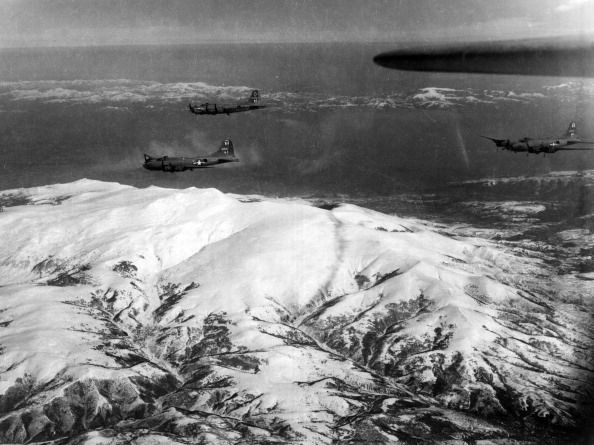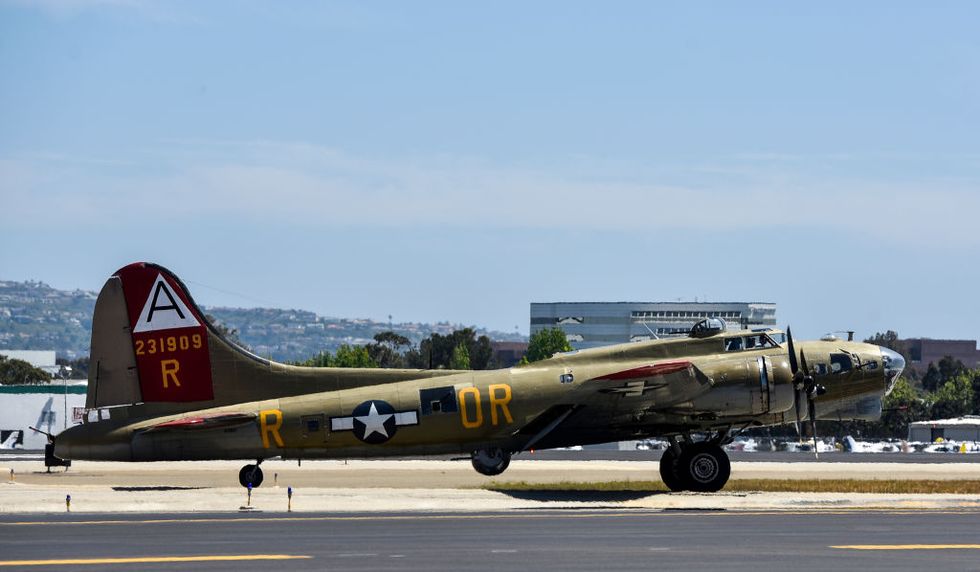- The original Nine-O-Nine was a decorated veteran of the air war over Europe.
- The second plane served as a water bomber and nuclear test target.
- The restored "Nine-O-Nine" crashed in 1987 and was subject to an extensive rebuilding.
Nine-O-Nine, the B-17 bomber involved in yesterday’s tragic crash in Connecticut, was built too late to serve in World War II, but was later rebuilt to resemble the original Nine O Nine, a veteran of the bomber campaign over Europe. The aircraft had a long postwar career, including a stint as a target in nuclear tests, before a lengthy rebuilding process restored her to flying condition. The bomber did have a close call in 1987, when a landing mishap severely damaged the aircraft.
The original Nine-O-Nine was a Boeing B-17G “Flying Fortress” bomber. Nearly 13,000 B-17s were built over the course of World War II, serving in both the Pacific and European theaters. Each four-engine bomber had a crew of ten, a top speed of 287 miles an hour, and could carry a payload of 4,500 bombs on a long distance bombing mission.
The B-17G was assigned to the 323rd Bomb Squadron, 91st Bomb Group. Nine-O-Nine was part of the legendary Eighth Air Force, or “Mighty Eighth,” a bomber force that struck strategic targets across Germany and occupied Europe. The aircraft’s name came from its serial number, the last three digits of which were 909. The airplane’s nose art depicted a Revolutionary War soldier holding a telescope and riding a bomb.
The Nine-O-Nine was assigned to the Eighth Air Force on February 25, 1944. By April 1945 she had flown 140 missions without a mission abort, which according to Airplanes of the Past “is believed to be the Eighth Air Force record for most missions.” Nine-O-Nine also never lost a crewman as a casualty. The bomber made eighteen trips to Berlin, flew 1,129 hours, and dropped 2,810 tons of bombs.
But the the bomber was dismantled after the war, and the second Nine-O-Nine was built at Long Beach, California, by the Douglas Aircraft Company and accepted for U.S. Army Air Force service in April 1945. The plane, serial number #44-83575, never saw combat but was converted to a SB-17G search and rescue aircraft in 1951 and served in Puerto Rico. The aircraft later served as part of the Military Air Transport Service, the precursor to the Air Force’s Air Mobility Command.
In 1952, retired from U.S. military service, the aircraft was renamed “Miss Yucca” and parked on a nuclear test range in Nevada. There she was subjected to three different nuclear explosions to test the effects of nuclear weapons on aircraft. After a 13-year “cooling down period” to allow radiation to subside, the bomber was sold as scrap to the Aircraft Specialties Company, which began a lengthy restoration. The bomber then served twenty years as a forest fire water bomber, dropping water and borate on forest fires.
In 1986 the bomber was sold to the Collings Foundation, which restored the plane to wartime condition as Nine-O-Nine. In 1987 the bomber was involved in a serious crash, which the Foundation described as follows:
In August 1987, while performing at an airshow in western Pennsylvania, “Nine-O-Nine” was caught by a severe crosswind moments after touchdown. The right wing lifted in the air, finally coming down too far down the runway. Despite the efforts of her crew, she rolled off the end of the runway, crashed through a chain link fence, sheared off a power pole and roared down a 100-foot ravine to a thundering stop. The landing gear sheared off, the chin turret was smashed and pushed into the nose; the Plexiglas nose was shattered; bomb bay doors, fuselage, fuselage, ball turret, wing and nacelles all took a tremendous beating. Engines and propellers were also torn form their mounts. Fortunately, there were no fatalities to the crew or riders although there were injuries.
Following the crash Nine-O-Nine was restored for a third time, stopping at over 1,200 locations before the October 2, 2019 accident, where tragically seven people lost their lives. A full investigation is still ongoing to determine what caused the crash.

Kyle Mizokami is a writer on defense and security issues and has been at Popular Mechanics since 2015. If it involves explosions or projectiles, he's generally in favor of it. Kyle’s articles have appeared at The Daily Beast, U.S. Naval Institute News, The Diplomat, Foreign Policy, Combat Aircraft Monthly, VICE News, and others. He lives in San Francisco.
















